International Marketing Research: UK Olive Oil Market for NZ Exporters
VerifiedAdded on 2021/04/21
|11
|3457
|66
Report
AI Summary
This report provides a comprehensive analysis of the UK olive oil market, specifically focusing on the opportunities and challenges for New Zealand olive oil exporters. It begins with an executive summary and introduction, highlighting the growing consumption of olive oil in the UK and its potential for New Zealand producers. The report then examines olive oil production in New Zealand, market trends in the UK, and consumer behavior. A detailed target market and competition analysis is provided, followed by a PEST (Political, Economic, Social, and Technological) analysis to assess the market environment. The report also addresses trade barriers, including the impact of Brexit on New Zealand exporters, and concludes with recommended marketing strategies. The analysis underscores the importance of understanding consumer preferences, addressing trade challenges, and developing effective marketing approaches to successfully penetrate the UK olive oil market.
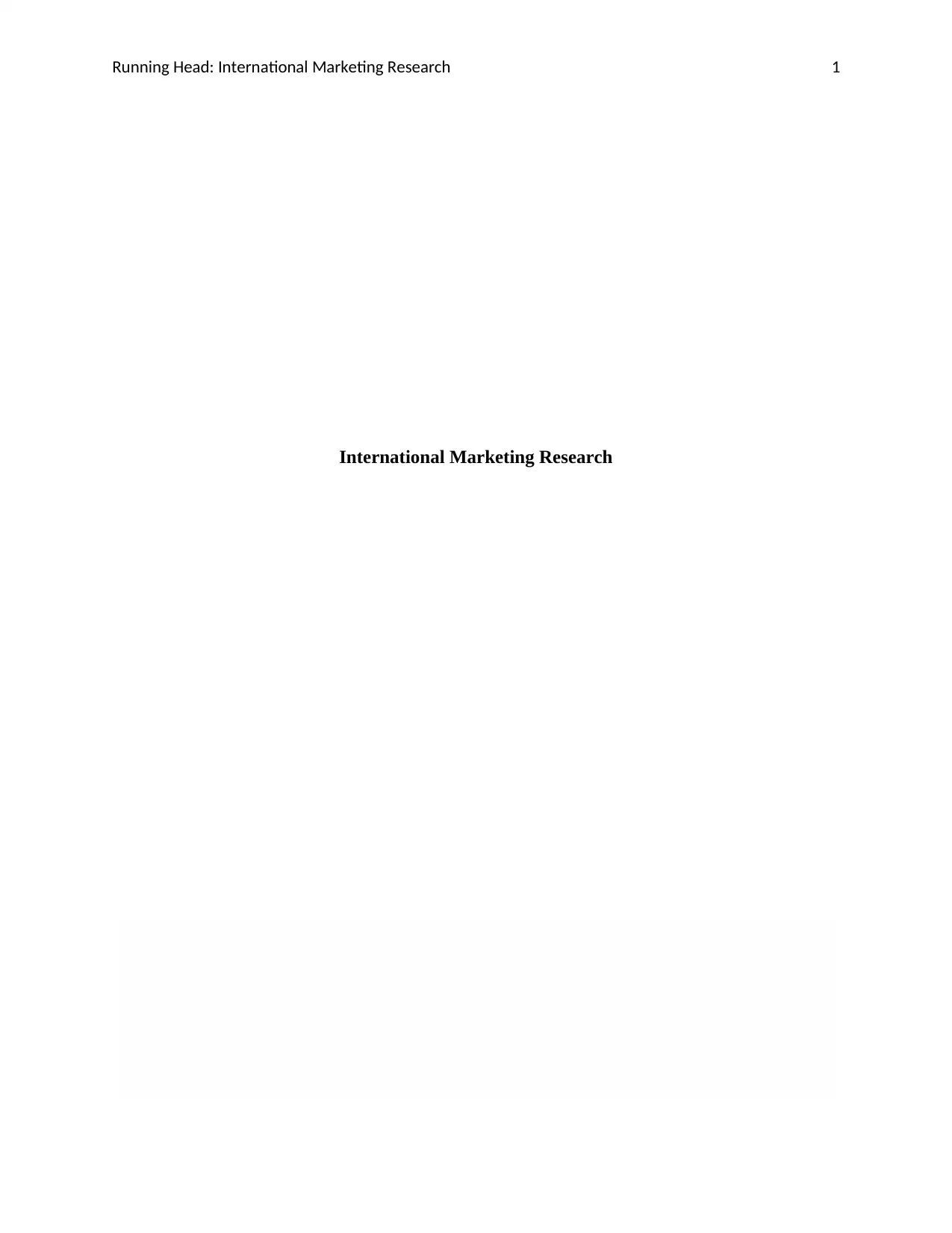
Running Head: International Marketing Research 1
International Marketing Research
International Marketing Research
Paraphrase This Document
Need a fresh take? Get an instant paraphrase of this document with our AI Paraphraser
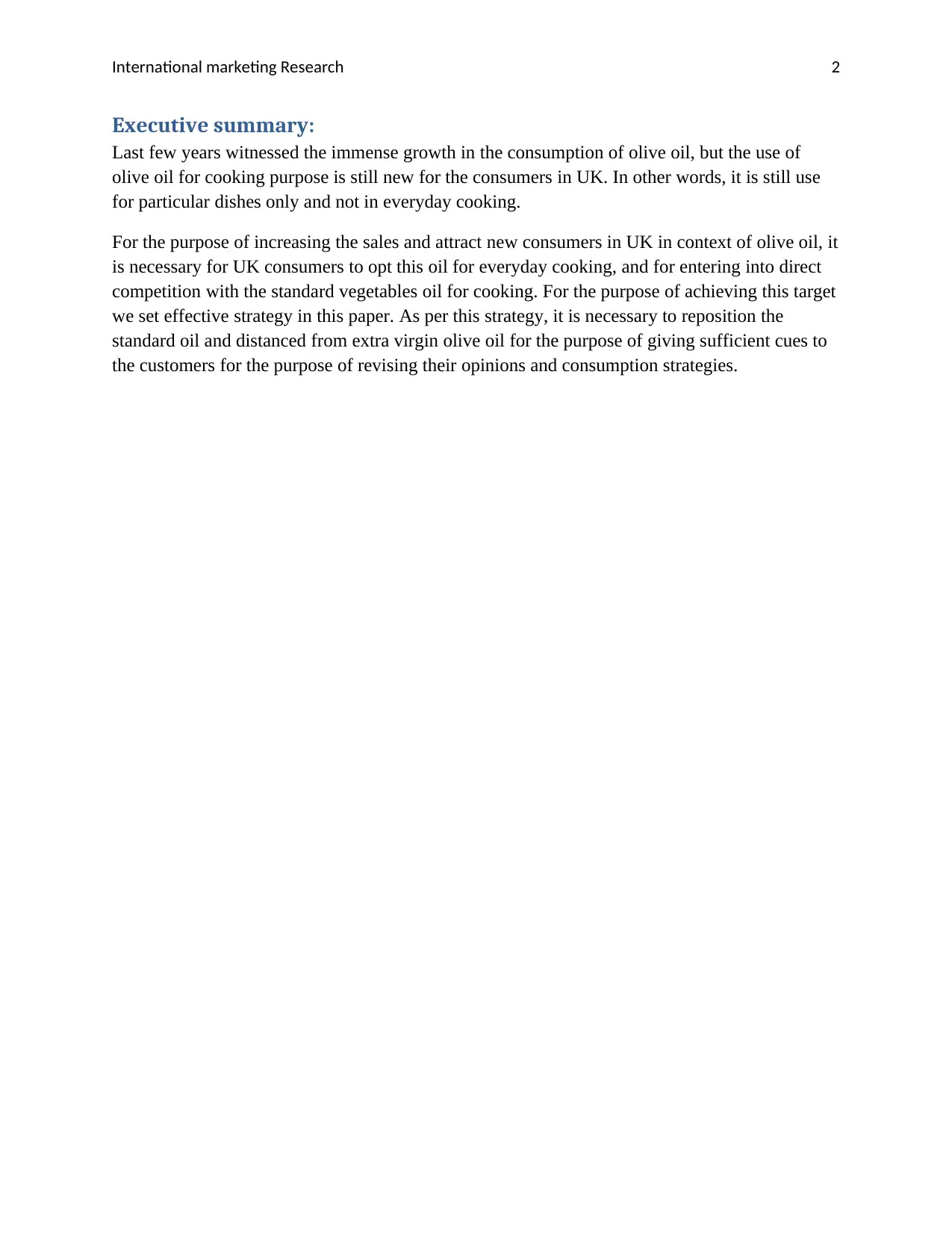
International marketing Research 2
Executive summary:
Last few years witnessed the immense growth in the consumption of olive oil, but the use of
olive oil for cooking purpose is still new for the consumers in UK. In other words, it is still use
for particular dishes only and not in everyday cooking.
For the purpose of increasing the sales and attract new consumers in UK in context of olive oil, it
is necessary for UK consumers to opt this oil for everyday cooking, and for entering into direct
competition with the standard vegetables oil for cooking. For the purpose of achieving this target
we set effective strategy in this paper. As per this strategy, it is necessary to reposition the
standard oil and distanced from extra virgin olive oil for the purpose of giving sufficient cues to
the customers for the purpose of revising their opinions and consumption strategies.
Executive summary:
Last few years witnessed the immense growth in the consumption of olive oil, but the use of
olive oil for cooking purpose is still new for the consumers in UK. In other words, it is still use
for particular dishes only and not in everyday cooking.
For the purpose of increasing the sales and attract new consumers in UK in context of olive oil, it
is necessary for UK consumers to opt this oil for everyday cooking, and for entering into direct
competition with the standard vegetables oil for cooking. For the purpose of achieving this target
we set effective strategy in this paper. As per this strategy, it is necessary to reposition the
standard oil and distanced from extra virgin olive oil for the purpose of giving sufficient cues to
the customers for the purpose of revising their opinions and consumption strategies.
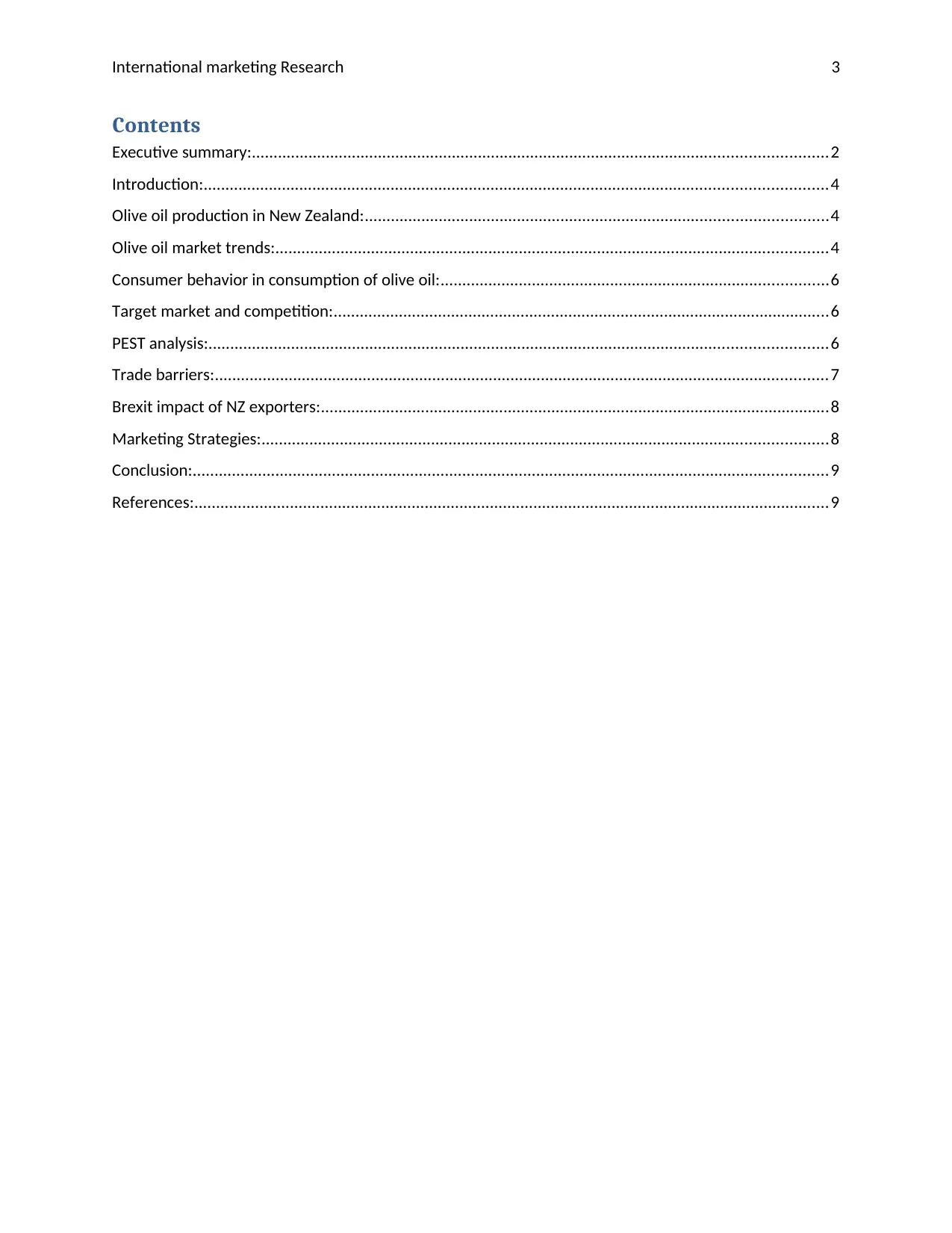
International marketing Research 3
Contents
Executive summary:....................................................................................................................................2
Introduction:...............................................................................................................................................4
Olive oil production in New Zealand:..........................................................................................................4
Olive oil market trends:...............................................................................................................................4
Consumer behavior in consumption of olive oil:.........................................................................................6
Target market and competition:..................................................................................................................6
PEST analysis:..............................................................................................................................................6
Trade barriers:.............................................................................................................................................7
Brexit impact of NZ exporters:.....................................................................................................................8
Marketing Strategies:..................................................................................................................................8
Conclusion:..................................................................................................................................................9
References:..................................................................................................................................................9
Contents
Executive summary:....................................................................................................................................2
Introduction:...............................................................................................................................................4
Olive oil production in New Zealand:..........................................................................................................4
Olive oil market trends:...............................................................................................................................4
Consumer behavior in consumption of olive oil:.........................................................................................6
Target market and competition:..................................................................................................................6
PEST analysis:..............................................................................................................................................6
Trade barriers:.............................................................................................................................................7
Brexit impact of NZ exporters:.....................................................................................................................8
Marketing Strategies:..................................................................................................................................8
Conclusion:..................................................................................................................................................9
References:..................................................................................................................................................9
⊘ This is a preview!⊘
Do you want full access?
Subscribe today to unlock all pages.

Trusted by 1+ million students worldwide
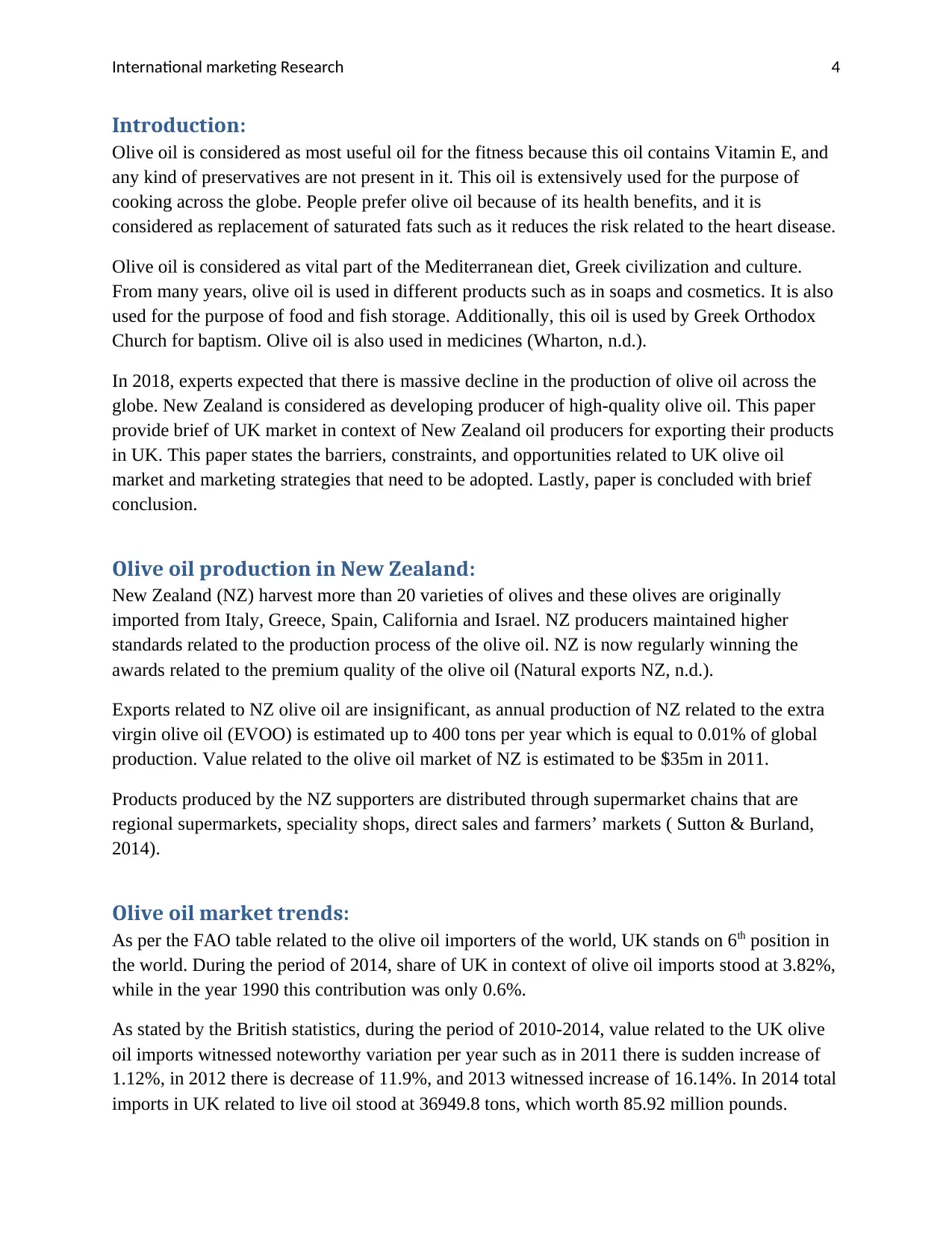
International marketing Research 4
Introduction:
Olive oil is considered as most useful oil for the fitness because this oil contains Vitamin E, and
any kind of preservatives are not present in it. This oil is extensively used for the purpose of
cooking across the globe. People prefer olive oil because of its health benefits, and it is
considered as replacement of saturated fats such as it reduces the risk related to the heart disease.
Olive oil is considered as vital part of the Mediterranean diet, Greek civilization and culture.
From many years, olive oil is used in different products such as in soaps and cosmetics. It is also
used for the purpose of food and fish storage. Additionally, this oil is used by Greek Orthodox
Church for baptism. Olive oil is also used in medicines (Wharton, n.d.).
In 2018, experts expected that there is massive decline in the production of olive oil across the
globe. New Zealand is considered as developing producer of high-quality olive oil. This paper
provide brief of UK market in context of New Zealand oil producers for exporting their products
in UK. This paper states the barriers, constraints, and opportunities related to UK olive oil
market and marketing strategies that need to be adopted. Lastly, paper is concluded with brief
conclusion.
Olive oil production in New Zealand:
New Zealand (NZ) harvest more than 20 varieties of olives and these olives are originally
imported from Italy, Greece, Spain, California and Israel. NZ producers maintained higher
standards related to the production process of the olive oil. NZ is now regularly winning the
awards related to the premium quality of the olive oil (Natural exports NZ, n.d.).
Exports related to NZ olive oil are insignificant, as annual production of NZ related to the extra
virgin olive oil (EVOO) is estimated up to 400 tons per year which is equal to 0.01% of global
production. Value related to the olive oil market of NZ is estimated to be $35m in 2011.
Products produced by the NZ supporters are distributed through supermarket chains that are
regional supermarkets, speciality shops, direct sales and farmers’ markets ( Sutton & Burland,
2014).
Olive oil market trends:
As per the FAO table related to the olive oil importers of the world, UK stands on 6th position in
the world. During the period of 2014, share of UK in context of olive oil imports stood at 3.82%,
while in the year 1990 this contribution was only 0.6%.
As stated by the British statistics, during the period of 2010-2014, value related to the UK olive
oil imports witnessed noteworthy variation per year such as in 2011 there is sudden increase of
1.12%, in 2012 there is decrease of 11.9%, and 2013 witnessed increase of 16.14%. In 2014 total
imports in UK related to live oil stood at 36949.8 tons, which worth 85.92 million pounds.
Introduction:
Olive oil is considered as most useful oil for the fitness because this oil contains Vitamin E, and
any kind of preservatives are not present in it. This oil is extensively used for the purpose of
cooking across the globe. People prefer olive oil because of its health benefits, and it is
considered as replacement of saturated fats such as it reduces the risk related to the heart disease.
Olive oil is considered as vital part of the Mediterranean diet, Greek civilization and culture.
From many years, olive oil is used in different products such as in soaps and cosmetics. It is also
used for the purpose of food and fish storage. Additionally, this oil is used by Greek Orthodox
Church for baptism. Olive oil is also used in medicines (Wharton, n.d.).
In 2018, experts expected that there is massive decline in the production of olive oil across the
globe. New Zealand is considered as developing producer of high-quality olive oil. This paper
provide brief of UK market in context of New Zealand oil producers for exporting their products
in UK. This paper states the barriers, constraints, and opportunities related to UK olive oil
market and marketing strategies that need to be adopted. Lastly, paper is concluded with brief
conclusion.
Olive oil production in New Zealand:
New Zealand (NZ) harvest more than 20 varieties of olives and these olives are originally
imported from Italy, Greece, Spain, California and Israel. NZ producers maintained higher
standards related to the production process of the olive oil. NZ is now regularly winning the
awards related to the premium quality of the olive oil (Natural exports NZ, n.d.).
Exports related to NZ olive oil are insignificant, as annual production of NZ related to the extra
virgin olive oil (EVOO) is estimated up to 400 tons per year which is equal to 0.01% of global
production. Value related to the olive oil market of NZ is estimated to be $35m in 2011.
Products produced by the NZ supporters are distributed through supermarket chains that are
regional supermarkets, speciality shops, direct sales and farmers’ markets ( Sutton & Burland,
2014).
Olive oil market trends:
As per the FAO table related to the olive oil importers of the world, UK stands on 6th position in
the world. During the period of 2014, share of UK in context of olive oil imports stood at 3.82%,
while in the year 1990 this contribution was only 0.6%.
As stated by the British statistics, during the period of 2010-2014, value related to the UK olive
oil imports witnessed noteworthy variation per year such as in 2011 there is sudden increase of
1.12%, in 2012 there is decrease of 11.9%, and 2013 witnessed increase of 16.14%. In 2014 total
imports in UK related to live oil stood at 36949.8 tons, which worth 85.92 million pounds.
Paraphrase This Document
Need a fresh take? Get an instant paraphrase of this document with our AI Paraphraser
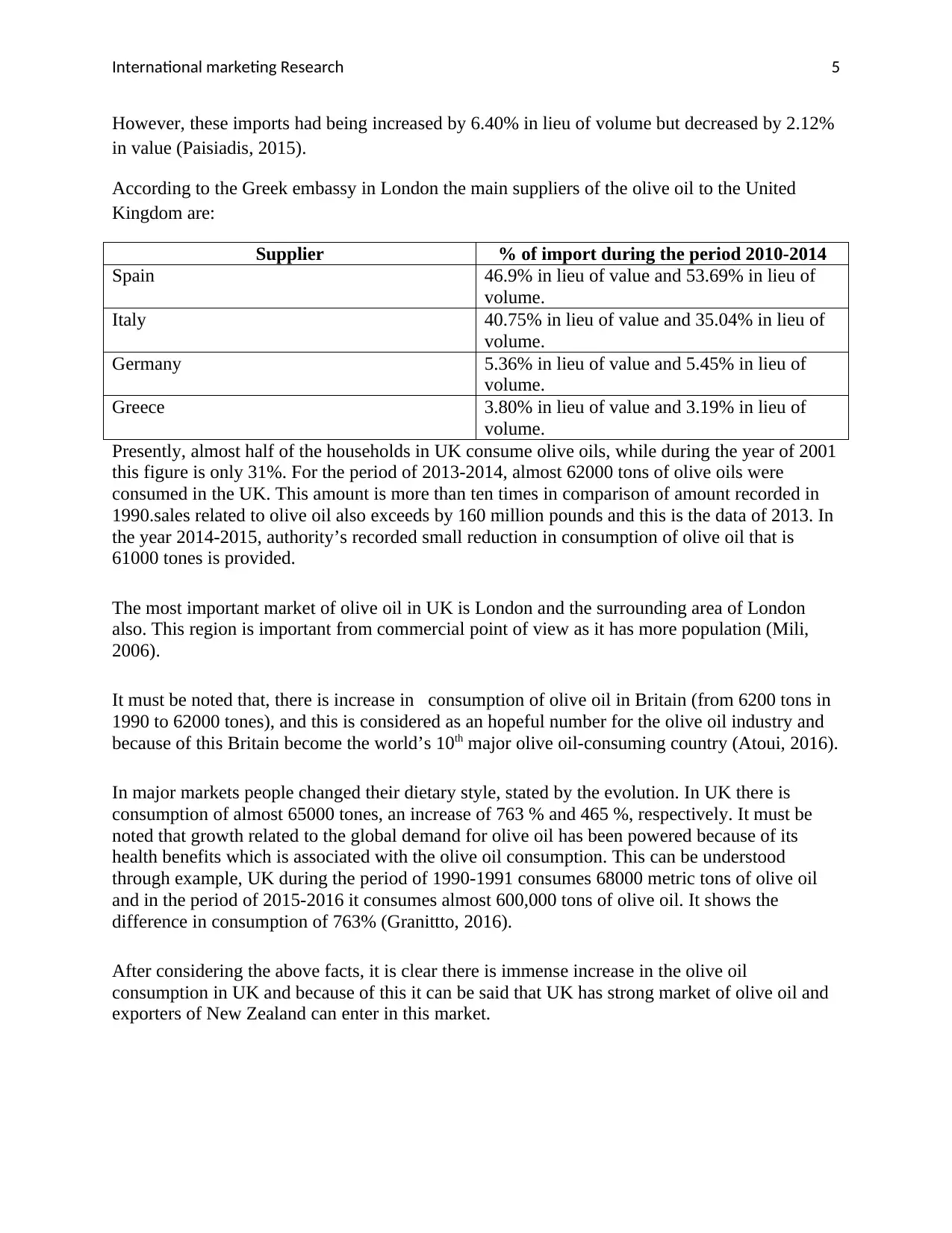
International marketing Research 5
However, these imports had being increased by 6.40% in lieu of volume but decreased by 2.12%
in value (Paisiadis, 2015).
According to the Greek embassy in London the main suppliers of the olive oil to the United
Kingdom are:
Supplier % of import during the period 2010-2014
Spain 46.9% in lieu of value and 53.69% in lieu of
volume.
Italy 40.75% in lieu of value and 35.04% in lieu of
volume.
Germany 5.36% in lieu of value and 5.45% in lieu of
volume.
Greece 3.80% in lieu of value and 3.19% in lieu of
volume.
Presently, almost half of the households in UK consume olive oils, while during the year of 2001
this figure is only 31%. For the period of 2013-2014, almost 62000 tons of olive oils were
consumed in the UK. This amount is more than ten times in comparison of amount recorded in
1990.sales related to olive oil also exceeds by 160 million pounds and this is the data of 2013. In
the year 2014-2015, authority’s recorded small reduction in consumption of olive oil that is
61000 tones is provided.
The most important market of olive oil in UK is London and the surrounding area of London
also. This region is important from commercial point of view as it has more population (Mili,
2006).
It must be noted that, there is increase in consumption of olive oil in Britain (from 6200 tons in
1990 to 62000 tones), and this is considered as an hopeful number for the olive oil industry and
because of this Britain become the world’s 10th major olive oil-consuming country (Atoui, 2016).
In major markets people changed their dietary style, stated by the evolution. In UK there is
consumption of almost 65000 tones, an increase of 763 % and 465 %, respectively. It must be
noted that growth related to the global demand for olive oil has been powered because of its
health benefits which is associated with the olive oil consumption. This can be understood
through example, UK during the period of 1990-1991 consumes 68000 metric tons of olive oil
and in the period of 2015-2016 it consumes almost 600,000 tons of olive oil. It shows the
difference in consumption of 763% (Granittto, 2016).
After considering the above facts, it is clear there is immense increase in the olive oil
consumption in UK and because of this it can be said that UK has strong market of olive oil and
exporters of New Zealand can enter in this market.
However, these imports had being increased by 6.40% in lieu of volume but decreased by 2.12%
in value (Paisiadis, 2015).
According to the Greek embassy in London the main suppliers of the olive oil to the United
Kingdom are:
Supplier % of import during the period 2010-2014
Spain 46.9% in lieu of value and 53.69% in lieu of
volume.
Italy 40.75% in lieu of value and 35.04% in lieu of
volume.
Germany 5.36% in lieu of value and 5.45% in lieu of
volume.
Greece 3.80% in lieu of value and 3.19% in lieu of
volume.
Presently, almost half of the households in UK consume olive oils, while during the year of 2001
this figure is only 31%. For the period of 2013-2014, almost 62000 tons of olive oils were
consumed in the UK. This amount is more than ten times in comparison of amount recorded in
1990.sales related to olive oil also exceeds by 160 million pounds and this is the data of 2013. In
the year 2014-2015, authority’s recorded small reduction in consumption of olive oil that is
61000 tones is provided.
The most important market of olive oil in UK is London and the surrounding area of London
also. This region is important from commercial point of view as it has more population (Mili,
2006).
It must be noted that, there is increase in consumption of olive oil in Britain (from 6200 tons in
1990 to 62000 tones), and this is considered as an hopeful number for the olive oil industry and
because of this Britain become the world’s 10th major olive oil-consuming country (Atoui, 2016).
In major markets people changed their dietary style, stated by the evolution. In UK there is
consumption of almost 65000 tones, an increase of 763 % and 465 %, respectively. It must be
noted that growth related to the global demand for olive oil has been powered because of its
health benefits which is associated with the olive oil consumption. This can be understood
through example, UK during the period of 1990-1991 consumes 68000 metric tons of olive oil
and in the period of 2015-2016 it consumes almost 600,000 tons of olive oil. It shows the
difference in consumption of 763% (Granittto, 2016).
After considering the above facts, it is clear there is immense increase in the olive oil
consumption in UK and because of this it can be said that UK has strong market of olive oil and
exporters of New Zealand can enter in this market.
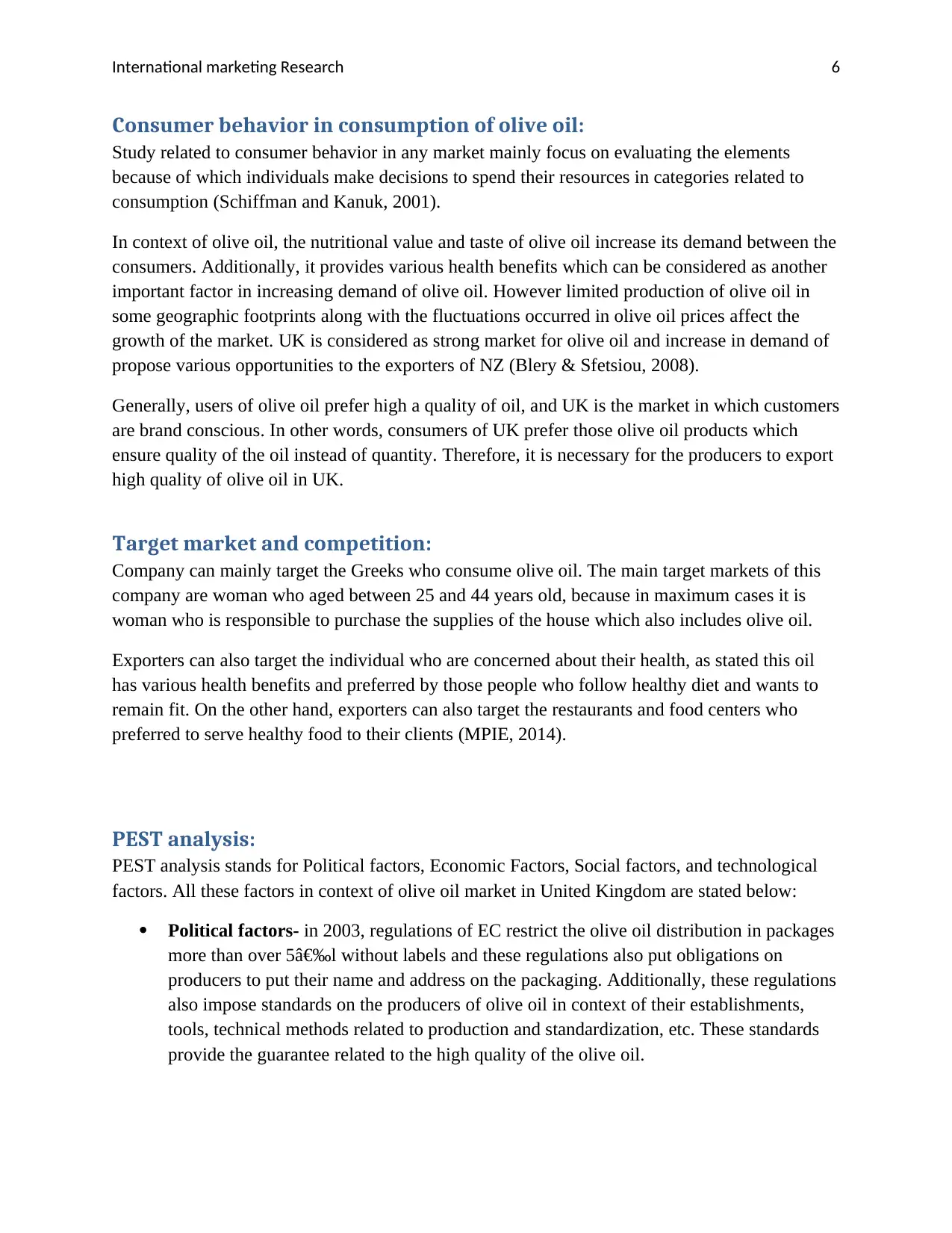
International marketing Research 6
Consumer behavior in consumption of olive oil:
Study related to consumer behavior in any market mainly focus on evaluating the elements
because of which individuals make decisions to spend their resources in categories related to
consumption (Schiffman and Kanuk, 2001).
In context of olive oil, the nutritional value and taste of olive oil increase its demand between the
consumers. Additionally, it provides various health benefits which can be considered as another
important factor in increasing demand of olive oil. However limited production of olive oil in
some geographic footprints along with the fluctuations occurred in olive oil prices affect the
growth of the market. UK is considered as strong market for olive oil and increase in demand of
propose various opportunities to the exporters of NZ (Blery & Sfetsiou, 2008).
Generally, users of olive oil prefer high a quality of oil, and UK is the market in which customers
are brand conscious. In other words, consumers of UK prefer those olive oil products which
ensure quality of the oil instead of quantity. Therefore, it is necessary for the producers to export
high quality of olive oil in UK.
Target market and competition:
Company can mainly target the Greeks who consume olive oil. The main target markets of this
company are woman who aged between 25 and 44 years old, because in maximum cases it is
woman who is responsible to purchase the supplies of the house which also includes olive oil.
Exporters can also target the individual who are concerned about their health, as stated this oil
has various health benefits and preferred by those people who follow healthy diet and wants to
remain fit. On the other hand, exporters can also target the restaurants and food centers who
preferred to serve healthy food to their clients (MPIE, 2014).
PEST analysis:
PEST analysis stands for Political factors, Economic Factors, Social factors, and technological
factors. All these factors in context of olive oil market in United Kingdom are stated below:
Political factors- in 2003, regulations of EC restrict the olive oil distribution in packages
more than over 5 l without labels and these regulations also put obligations on
producers to put their name and address on the packaging. Additionally, these regulations
also impose standards on the producers of olive oil in context of their establishments,
tools, technical methods related to production and standardization, etc. These standards
provide the guarantee related to the high quality of the olive oil.
Consumer behavior in consumption of olive oil:
Study related to consumer behavior in any market mainly focus on evaluating the elements
because of which individuals make decisions to spend their resources in categories related to
consumption (Schiffman and Kanuk, 2001).
In context of olive oil, the nutritional value and taste of olive oil increase its demand between the
consumers. Additionally, it provides various health benefits which can be considered as another
important factor in increasing demand of olive oil. However limited production of olive oil in
some geographic footprints along with the fluctuations occurred in olive oil prices affect the
growth of the market. UK is considered as strong market for olive oil and increase in demand of
propose various opportunities to the exporters of NZ (Blery & Sfetsiou, 2008).
Generally, users of olive oil prefer high a quality of oil, and UK is the market in which customers
are brand conscious. In other words, consumers of UK prefer those olive oil products which
ensure quality of the oil instead of quantity. Therefore, it is necessary for the producers to export
high quality of olive oil in UK.
Target market and competition:
Company can mainly target the Greeks who consume olive oil. The main target markets of this
company are woman who aged between 25 and 44 years old, because in maximum cases it is
woman who is responsible to purchase the supplies of the house which also includes olive oil.
Exporters can also target the individual who are concerned about their health, as stated this oil
has various health benefits and preferred by those people who follow healthy diet and wants to
remain fit. On the other hand, exporters can also target the restaurants and food centers who
preferred to serve healthy food to their clients (MPIE, 2014).
PEST analysis:
PEST analysis stands for Political factors, Economic Factors, Social factors, and technological
factors. All these factors in context of olive oil market in United Kingdom are stated below:
Political factors- in 2003, regulations of EC restrict the olive oil distribution in packages
more than over 5 l without labels and these regulations also put obligations on
producers to put their name and address on the packaging. Additionally, these regulations
also impose standards on the producers of olive oil in context of their establishments,
tools, technical methods related to production and standardization, etc. These standards
provide the guarantee related to the high quality of the olive oil.
⊘ This is a preview!⊘
Do you want full access?
Subscribe today to unlock all pages.

Trusted by 1+ million students worldwide
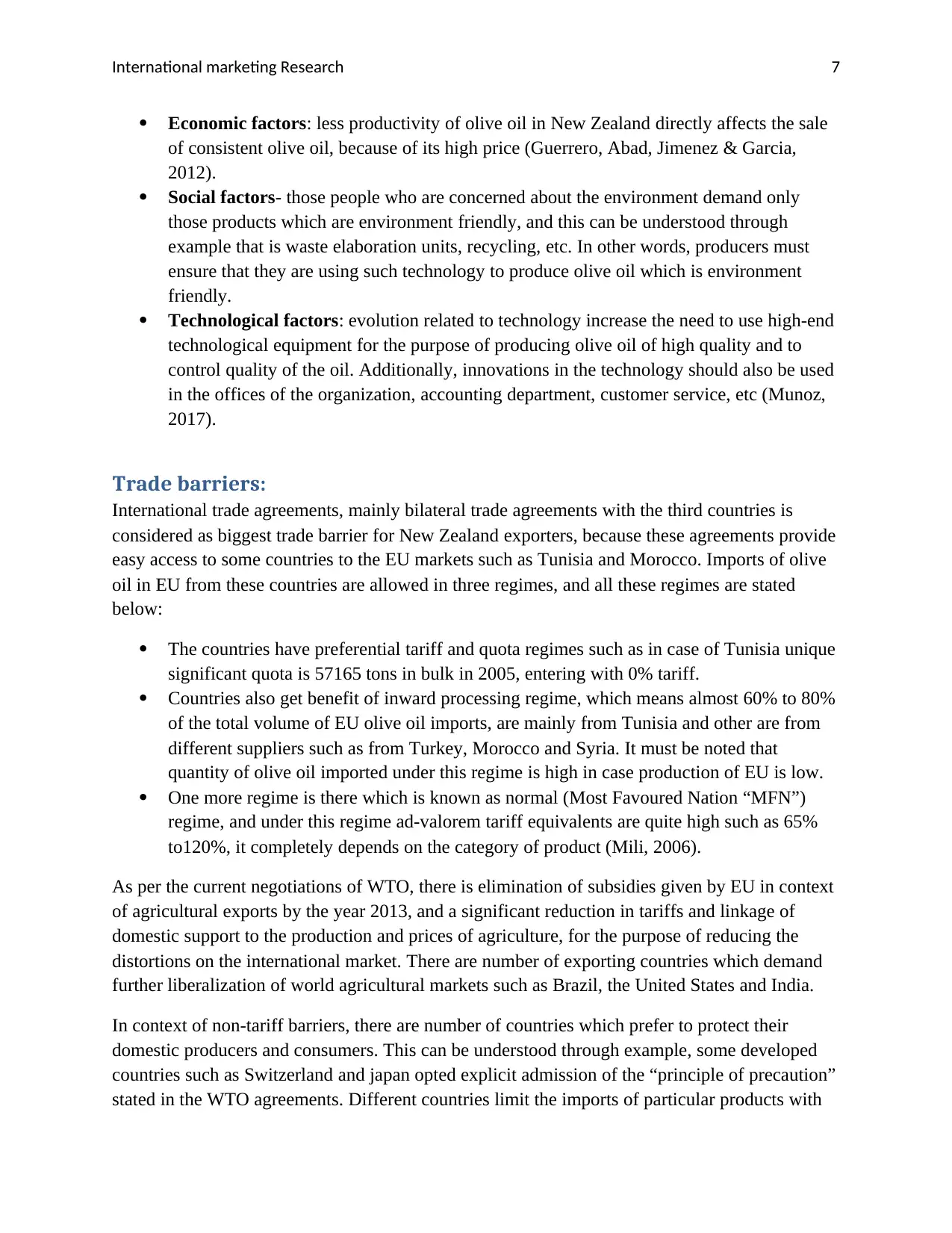
International marketing Research 7
Economic factors: less productivity of olive oil in New Zealand directly affects the sale
of consistent olive oil, because of its high price (Guerrero, Abad, Jimenez & Garcia,
2012).
Social factors- those people who are concerned about the environment demand only
those products which are environment friendly, and this can be understood through
example that is waste elaboration units, recycling, etc. In other words, producers must
ensure that they are using such technology to produce olive oil which is environment
friendly.
Technological factors: evolution related to technology increase the need to use high-end
technological equipment for the purpose of producing olive oil of high quality and to
control quality of the oil. Additionally, innovations in the technology should also be used
in the offices of the organization, accounting department, customer service, etc (Munoz,
2017).
Trade barriers:
International trade agreements, mainly bilateral trade agreements with the third countries is
considered as biggest trade barrier for New Zealand exporters, because these agreements provide
easy access to some countries to the EU markets such as Tunisia and Morocco. Imports of olive
oil in EU from these countries are allowed in three regimes, and all these regimes are stated
below:
The countries have preferential tariff and quota regimes such as in case of Tunisia unique
significant quota is 57165 tons in bulk in 2005, entering with 0% tariff.
Countries also get benefit of inward processing regime, which means almost 60% to 80%
of the total volume of EU olive oil imports, are mainly from Tunisia and other are from
different suppliers such as from Turkey, Morocco and Syria. It must be noted that
quantity of olive oil imported under this regime is high in case production of EU is low.
One more regime is there which is known as normal (Most Favoured Nation “MFN”)
regime, and under this regime ad-valorem tariff equivalents are quite high such as 65%
to120%, it completely depends on the category of product (Mili, 2006).
As per the current negotiations of WTO, there is elimination of subsidies given by EU in context
of agricultural exports by the year 2013, and a significant reduction in tariffs and linkage of
domestic support to the production and prices of agriculture, for the purpose of reducing the
distortions on the international market. There are number of exporting countries which demand
further liberalization of world agricultural markets such as Brazil, the United States and India.
In context of non-tariff barriers, there are number of countries which prefer to protect their
domestic producers and consumers. This can be understood through example, some developed
countries such as Switzerland and japan opted explicit admission of the “principle of precaution”
stated in the WTO agreements. Different countries limit the imports of particular products with
Economic factors: less productivity of olive oil in New Zealand directly affects the sale
of consistent olive oil, because of its high price (Guerrero, Abad, Jimenez & Garcia,
2012).
Social factors- those people who are concerned about the environment demand only
those products which are environment friendly, and this can be understood through
example that is waste elaboration units, recycling, etc. In other words, producers must
ensure that they are using such technology to produce olive oil which is environment
friendly.
Technological factors: evolution related to technology increase the need to use high-end
technological equipment for the purpose of producing olive oil of high quality and to
control quality of the oil. Additionally, innovations in the technology should also be used
in the offices of the organization, accounting department, customer service, etc (Munoz,
2017).
Trade barriers:
International trade agreements, mainly bilateral trade agreements with the third countries is
considered as biggest trade barrier for New Zealand exporters, because these agreements provide
easy access to some countries to the EU markets such as Tunisia and Morocco. Imports of olive
oil in EU from these countries are allowed in three regimes, and all these regimes are stated
below:
The countries have preferential tariff and quota regimes such as in case of Tunisia unique
significant quota is 57165 tons in bulk in 2005, entering with 0% tariff.
Countries also get benefit of inward processing regime, which means almost 60% to 80%
of the total volume of EU olive oil imports, are mainly from Tunisia and other are from
different suppliers such as from Turkey, Morocco and Syria. It must be noted that
quantity of olive oil imported under this regime is high in case production of EU is low.
One more regime is there which is known as normal (Most Favoured Nation “MFN”)
regime, and under this regime ad-valorem tariff equivalents are quite high such as 65%
to120%, it completely depends on the category of product (Mili, 2006).
As per the current negotiations of WTO, there is elimination of subsidies given by EU in context
of agricultural exports by the year 2013, and a significant reduction in tariffs and linkage of
domestic support to the production and prices of agriculture, for the purpose of reducing the
distortions on the international market. There are number of exporting countries which demand
further liberalization of world agricultural markets such as Brazil, the United States and India.
In context of non-tariff barriers, there are number of countries which prefer to protect their
domestic producers and consumers. This can be understood through example, some developed
countries such as Switzerland and japan opted explicit admission of the “principle of precaution”
stated in the WTO agreements. Different countries limit the imports of particular products with
Paraphrase This Document
Need a fresh take? Get an instant paraphrase of this document with our AI Paraphraser
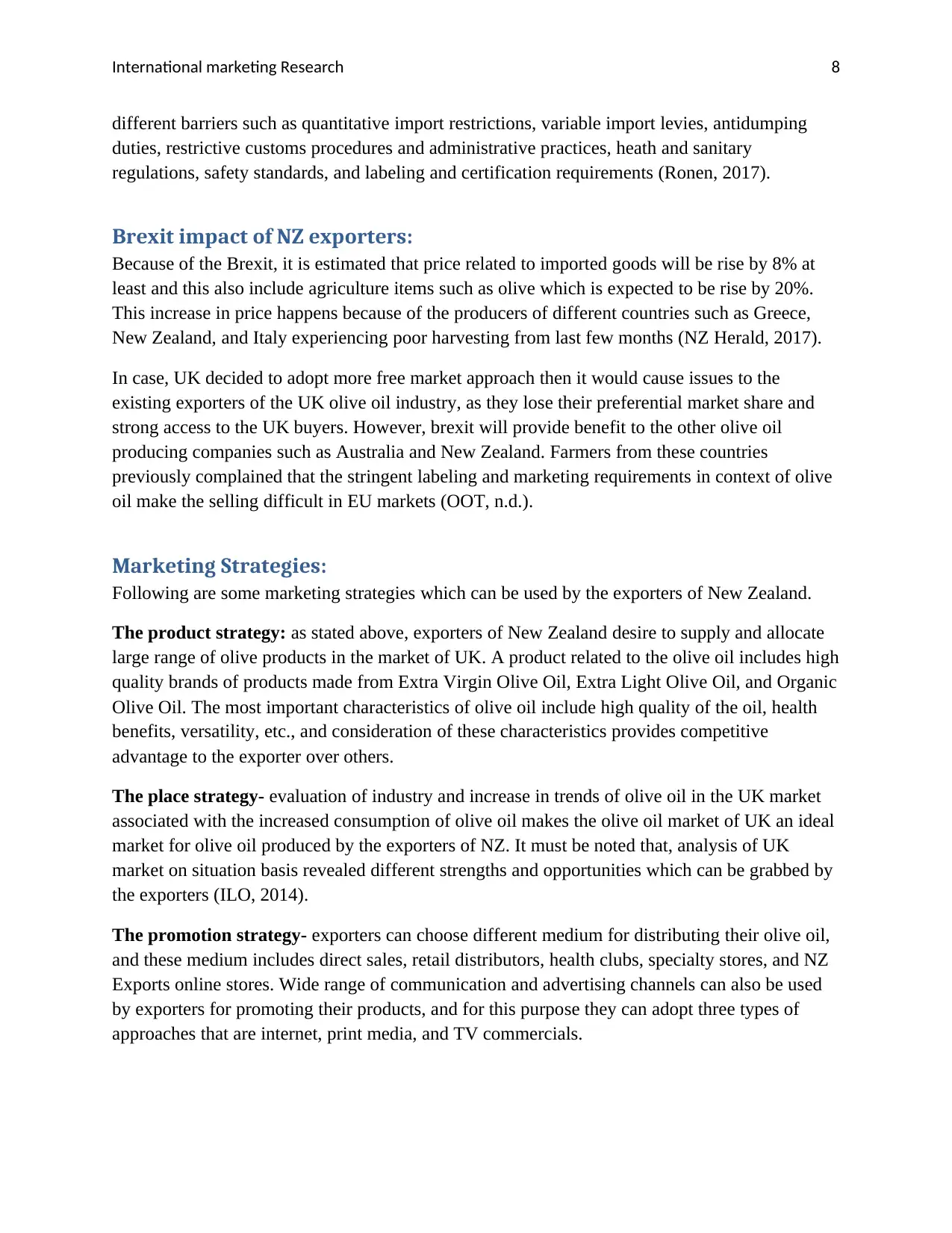
International marketing Research 8
different barriers such as quantitative import restrictions, variable import levies, antidumping
duties, restrictive customs procedures and administrative practices, heath and sanitary
regulations, safety standards, and labeling and certification requirements (Ronen, 2017).
Brexit impact of NZ exporters:
Because of the Brexit, it is estimated that price related to imported goods will be rise by 8% at
least and this also include agriculture items such as olive which is expected to be rise by 20%.
This increase in price happens because of the producers of different countries such as Greece,
New Zealand, and Italy experiencing poor harvesting from last few months (NZ Herald, 2017).
In case, UK decided to adopt more free market approach then it would cause issues to the
existing exporters of the UK olive oil industry, as they lose their preferential market share and
strong access to the UK buyers. However, brexit will provide benefit to the other olive oil
producing companies such as Australia and New Zealand. Farmers from these countries
previously complained that the stringent labeling and marketing requirements in context of olive
oil make the selling difficult in EU markets (OOT, n.d.).
Marketing Strategies:
Following are some marketing strategies which can be used by the exporters of New Zealand.
The product strategy: as stated above, exporters of New Zealand desire to supply and allocate
large range of olive products in the market of UK. A product related to the olive oil includes high
quality brands of products made from Extra Virgin Olive Oil, Extra Light Olive Oil, and Organic
Olive Oil. The most important characteristics of olive oil include high quality of the oil, health
benefits, versatility, etc., and consideration of these characteristics provides competitive
advantage to the exporter over others.
The place strategy- evaluation of industry and increase in trends of olive oil in the UK market
associated with the increased consumption of olive oil makes the olive oil market of UK an ideal
market for olive oil produced by the exporters of NZ. It must be noted that, analysis of UK
market on situation basis revealed different strengths and opportunities which can be grabbed by
the exporters (ILO, 2014).
The promotion strategy- exporters can choose different medium for distributing their olive oil,
and these medium includes direct sales, retail distributors, health clubs, specialty stores, and NZ
Exports online stores. Wide range of communication and advertising channels can also be used
by exporters for promoting their products, and for this purpose they can adopt three types of
approaches that are internet, print media, and TV commercials.
different barriers such as quantitative import restrictions, variable import levies, antidumping
duties, restrictive customs procedures and administrative practices, heath and sanitary
regulations, safety standards, and labeling and certification requirements (Ronen, 2017).
Brexit impact of NZ exporters:
Because of the Brexit, it is estimated that price related to imported goods will be rise by 8% at
least and this also include agriculture items such as olive which is expected to be rise by 20%.
This increase in price happens because of the producers of different countries such as Greece,
New Zealand, and Italy experiencing poor harvesting from last few months (NZ Herald, 2017).
In case, UK decided to adopt more free market approach then it would cause issues to the
existing exporters of the UK olive oil industry, as they lose their preferential market share and
strong access to the UK buyers. However, brexit will provide benefit to the other olive oil
producing companies such as Australia and New Zealand. Farmers from these countries
previously complained that the stringent labeling and marketing requirements in context of olive
oil make the selling difficult in EU markets (OOT, n.d.).
Marketing Strategies:
Following are some marketing strategies which can be used by the exporters of New Zealand.
The product strategy: as stated above, exporters of New Zealand desire to supply and allocate
large range of olive products in the market of UK. A product related to the olive oil includes high
quality brands of products made from Extra Virgin Olive Oil, Extra Light Olive Oil, and Organic
Olive Oil. The most important characteristics of olive oil include high quality of the oil, health
benefits, versatility, etc., and consideration of these characteristics provides competitive
advantage to the exporter over others.
The place strategy- evaluation of industry and increase in trends of olive oil in the UK market
associated with the increased consumption of olive oil makes the olive oil market of UK an ideal
market for olive oil produced by the exporters of NZ. It must be noted that, analysis of UK
market on situation basis revealed different strengths and opportunities which can be grabbed by
the exporters (ILO, 2014).
The promotion strategy- exporters can choose different medium for distributing their olive oil,
and these medium includes direct sales, retail distributors, health clubs, specialty stores, and NZ
Exports online stores. Wide range of communication and advertising channels can also be used
by exporters for promoting their products, and for this purpose they can adopt three types of
approaches that are internet, print media, and TV commercials.
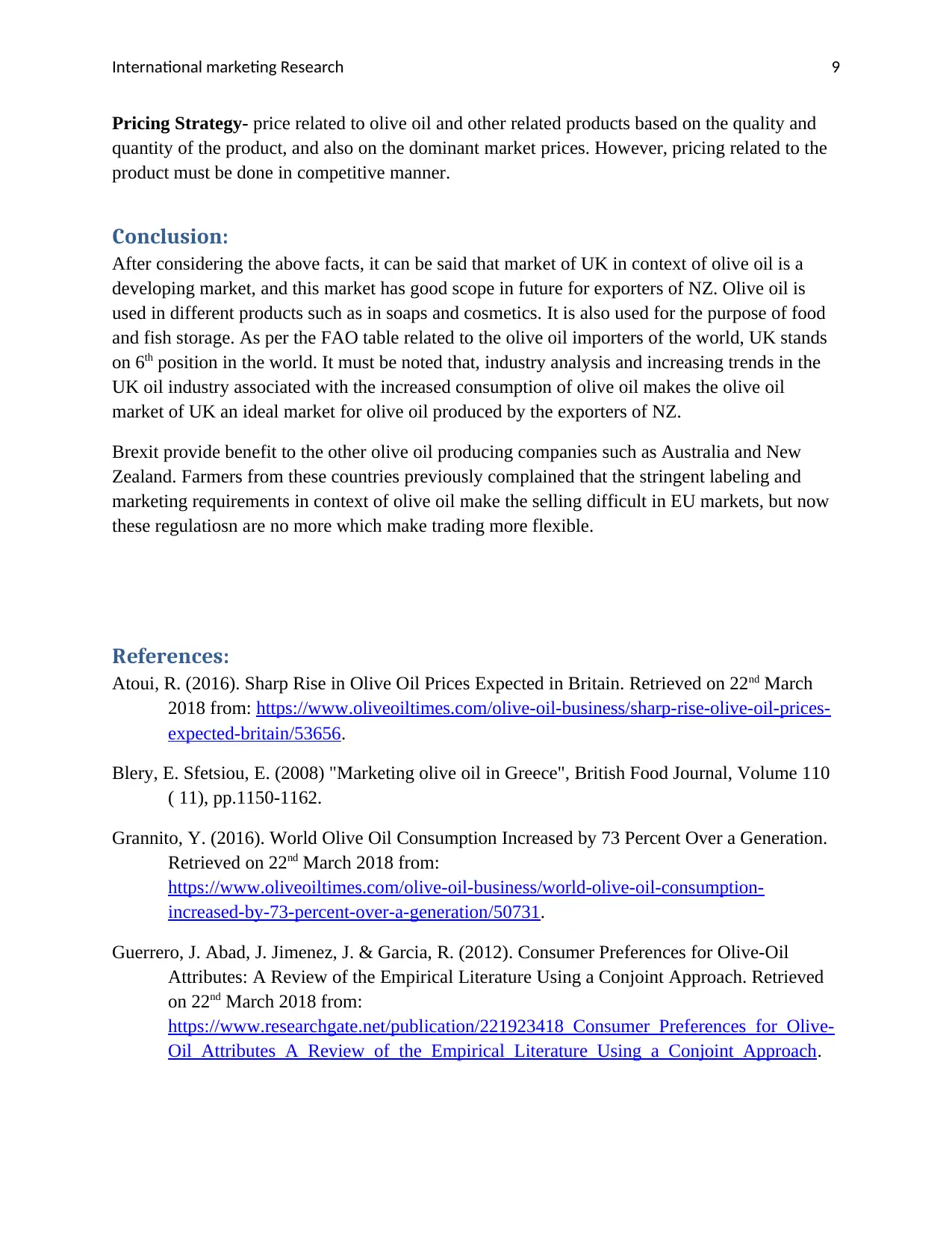
International marketing Research 9
Pricing Strategy- price related to olive oil and other related products based on the quality and
quantity of the product, and also on the dominant market prices. However, pricing related to the
product must be done in competitive manner.
Conclusion:
After considering the above facts, it can be said that market of UK in context of olive oil is a
developing market, and this market has good scope in future for exporters of NZ. Olive oil is
used in different products such as in soaps and cosmetics. It is also used for the purpose of food
and fish storage. As per the FAO table related to the olive oil importers of the world, UK stands
on 6th position in the world. It must be noted that, industry analysis and increasing trends in the
UK oil industry associated with the increased consumption of olive oil makes the olive oil
market of UK an ideal market for olive oil produced by the exporters of NZ.
Brexit provide benefit to the other olive oil producing companies such as Australia and New
Zealand. Farmers from these countries previously complained that the stringent labeling and
marketing requirements in context of olive oil make the selling difficult in EU markets, but now
these regulatiosn are no more which make trading more flexible.
References:
Atoui, R. (2016). Sharp Rise in Olive Oil Prices Expected in Britain. Retrieved on 22nd March
2018 from: https://www.oliveoiltimes.com/olive-oil-business/sharp-rise-olive-oil-prices-
expected-britain/53656.
Blery, E. Sfetsiou, E. (2008) "Marketing olive oil in Greece", British Food Journal, Volume 110
( 11), pp.1150-1162.
Grannito, Y. (2016). World Olive Oil Consumption Increased by 73 Percent Over a Generation.
Retrieved on 22nd March 2018 from:
https://www.oliveoiltimes.com/olive-oil-business/world-olive-oil-consumption-
increased-by-73-percent-over-a-generation/50731.
Guerrero, J. Abad, J. Jimenez, J. & Garcia, R. (2012). Consumer Preferences for Olive-Oil
Attributes: A Review of the Empirical Literature Using a Conjoint Approach. Retrieved
on 22nd March 2018 from:
https://www.researchgate.net/publication/221923418_Consumer_Preferences_for_Olive-
Oil_Attributes_A_Review_of_the_Empirical_Literature_Using_a_Conjoint_Approach.
Pricing Strategy- price related to olive oil and other related products based on the quality and
quantity of the product, and also on the dominant market prices. However, pricing related to the
product must be done in competitive manner.
Conclusion:
After considering the above facts, it can be said that market of UK in context of olive oil is a
developing market, and this market has good scope in future for exporters of NZ. Olive oil is
used in different products such as in soaps and cosmetics. It is also used for the purpose of food
and fish storage. As per the FAO table related to the olive oil importers of the world, UK stands
on 6th position in the world. It must be noted that, industry analysis and increasing trends in the
UK oil industry associated with the increased consumption of olive oil makes the olive oil
market of UK an ideal market for olive oil produced by the exporters of NZ.
Brexit provide benefit to the other olive oil producing companies such as Australia and New
Zealand. Farmers from these countries previously complained that the stringent labeling and
marketing requirements in context of olive oil make the selling difficult in EU markets, but now
these regulatiosn are no more which make trading more flexible.
References:
Atoui, R. (2016). Sharp Rise in Olive Oil Prices Expected in Britain. Retrieved on 22nd March
2018 from: https://www.oliveoiltimes.com/olive-oil-business/sharp-rise-olive-oil-prices-
expected-britain/53656.
Blery, E. Sfetsiou, E. (2008) "Marketing olive oil in Greece", British Food Journal, Volume 110
( 11), pp.1150-1162.
Grannito, Y. (2016). World Olive Oil Consumption Increased by 73 Percent Over a Generation.
Retrieved on 22nd March 2018 from:
https://www.oliveoiltimes.com/olive-oil-business/world-olive-oil-consumption-
increased-by-73-percent-over-a-generation/50731.
Guerrero, J. Abad, J. Jimenez, J. & Garcia, R. (2012). Consumer Preferences for Olive-Oil
Attributes: A Review of the Empirical Literature Using a Conjoint Approach. Retrieved
on 22nd March 2018 from:
https://www.researchgate.net/publication/221923418_Consumer_Preferences_for_Olive-
Oil_Attributes_A_Review_of_the_Empirical_Literature_Using_a_Conjoint_Approach.
⊘ This is a preview!⊘
Do you want full access?
Subscribe today to unlock all pages.

Trusted by 1+ million students worldwide
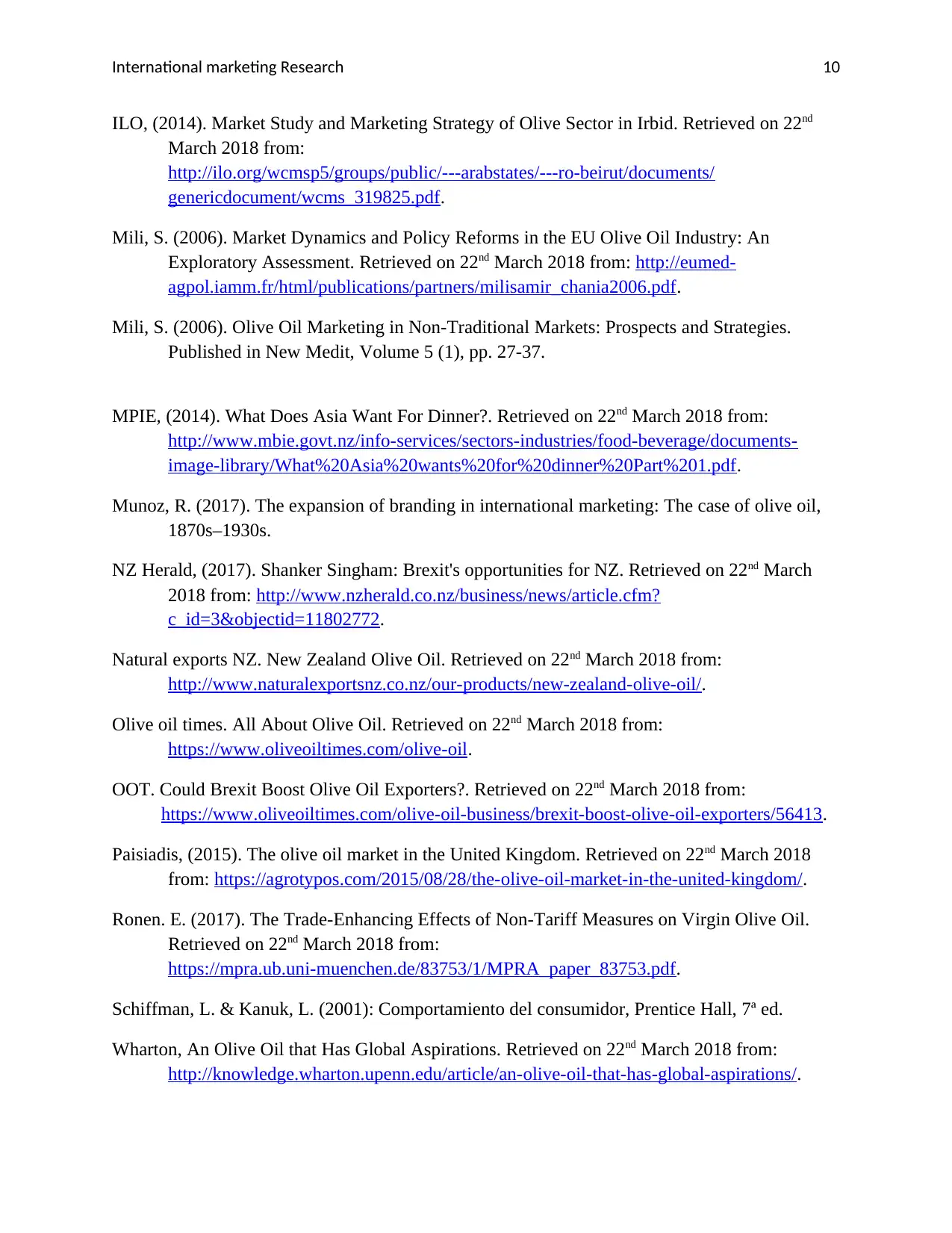
International marketing Research 10
ILO, (2014). Market Study and Marketing Strategy of Olive Sector in Irbid. Retrieved on 22nd
March 2018 from:
http://ilo.org/wcmsp5/groups/public/---arabstates/---ro-beirut/documents/
genericdocument/wcms_319825.pdf.
Mili, S. (2006). Market Dynamics and Policy Reforms in the EU Olive Oil Industry: An
Exploratory Assessment. Retrieved on 22nd March 2018 from: http://eumed-
agpol.iamm.fr/html/publications/partners/milisamir_chania2006.pdf.
Mili, S. (2006). Olive Oil Marketing in Non-Traditional Markets: Prospects and Strategies.
Published in New Medit, Volume 5 (1), pp. 27-37.
MPIE, (2014). What Does Asia Want For Dinner?. Retrieved on 22nd March 2018 from:
http://www.mbie.govt.nz/info-services/sectors-industries/food-beverage/documents-
image-library/What%20Asia%20wants%20for%20dinner%20Part%201.pdf.
Munoz, R. (2017). The expansion of branding in international marketing: The case of olive oil,
1870s–1930s.
NZ Herald, (2017). Shanker Singham: Brexit's opportunities for NZ. Retrieved on 22nd March
2018 from: http://www.nzherald.co.nz/business/news/article.cfm?
c_id=3&objectid=11802772.
Natural exports NZ. New Zealand Olive Oil. Retrieved on 22nd March 2018 from:
http://www.naturalexportsnz.co.nz/our-products/new-zealand-olive-oil/.
Olive oil times. All About Olive Oil. Retrieved on 22nd March 2018 from:
https://www.oliveoiltimes.com/olive-oil.
OOT. Could Brexit Boost Olive Oil Exporters?. Retrieved on 22nd March 2018 from:
https://www.oliveoiltimes.com/olive-oil-business/brexit-boost-olive-oil-exporters/56413.
Paisiadis, (2015). The olive oil market in the United Kingdom. Retrieved on 22nd March 2018
from: https://agrotypos.com/2015/08/28/the-olive-oil-market-in-the-united-kingdom/.
Ronen. E. (2017). The Trade-Enhancing Effects of Non-Tariff Measures on Virgin Olive Oil.
Retrieved on 22nd March 2018 from:
https://mpra.ub.uni-muenchen.de/83753/1/MPRA_paper_83753.pdf.
Schiffman, L. & Kanuk, L. (2001): Comportamiento del consumidor, Prentice Hall, 7ª ed.
Wharton, An Olive Oil that Has Global Aspirations. Retrieved on 22nd March 2018 from:
http://knowledge.wharton.upenn.edu/article/an-olive-oil-that-has-global-aspirations/.
ILO, (2014). Market Study and Marketing Strategy of Olive Sector in Irbid. Retrieved on 22nd
March 2018 from:
http://ilo.org/wcmsp5/groups/public/---arabstates/---ro-beirut/documents/
genericdocument/wcms_319825.pdf.
Mili, S. (2006). Market Dynamics and Policy Reforms in the EU Olive Oil Industry: An
Exploratory Assessment. Retrieved on 22nd March 2018 from: http://eumed-
agpol.iamm.fr/html/publications/partners/milisamir_chania2006.pdf.
Mili, S. (2006). Olive Oil Marketing in Non-Traditional Markets: Prospects and Strategies.
Published in New Medit, Volume 5 (1), pp. 27-37.
MPIE, (2014). What Does Asia Want For Dinner?. Retrieved on 22nd March 2018 from:
http://www.mbie.govt.nz/info-services/sectors-industries/food-beverage/documents-
image-library/What%20Asia%20wants%20for%20dinner%20Part%201.pdf.
Munoz, R. (2017). The expansion of branding in international marketing: The case of olive oil,
1870s–1930s.
NZ Herald, (2017). Shanker Singham: Brexit's opportunities for NZ. Retrieved on 22nd March
2018 from: http://www.nzherald.co.nz/business/news/article.cfm?
c_id=3&objectid=11802772.
Natural exports NZ. New Zealand Olive Oil. Retrieved on 22nd March 2018 from:
http://www.naturalexportsnz.co.nz/our-products/new-zealand-olive-oil/.
Olive oil times. All About Olive Oil. Retrieved on 22nd March 2018 from:
https://www.oliveoiltimes.com/olive-oil.
OOT. Could Brexit Boost Olive Oil Exporters?. Retrieved on 22nd March 2018 from:
https://www.oliveoiltimes.com/olive-oil-business/brexit-boost-olive-oil-exporters/56413.
Paisiadis, (2015). The olive oil market in the United Kingdom. Retrieved on 22nd March 2018
from: https://agrotypos.com/2015/08/28/the-olive-oil-market-in-the-united-kingdom/.
Ronen. E. (2017). The Trade-Enhancing Effects of Non-Tariff Measures on Virgin Olive Oil.
Retrieved on 22nd March 2018 from:
https://mpra.ub.uni-muenchen.de/83753/1/MPRA_paper_83753.pdf.
Schiffman, L. & Kanuk, L. (2001): Comportamiento del consumidor, Prentice Hall, 7ª ed.
Wharton, An Olive Oil that Has Global Aspirations. Retrieved on 22nd March 2018 from:
http://knowledge.wharton.upenn.edu/article/an-olive-oil-that-has-global-aspirations/.
Paraphrase This Document
Need a fresh take? Get an instant paraphrase of this document with our AI Paraphraser

International marketing Research 11
Sutton, H. & Burland, J. (2014). A boutique olive oil grove in new zealand: from investment to
consumer sales. Retrieved on 22nd March 2018 from: http://www.olivesnz.org.nz/wp-
content/uploads/2014/10/Boutique-Olive-Grove-in-NZ-case-study-Sutton-and-Burland-
2014.pdf.
Sutton, H. & Burland, J. (2014). A boutique olive oil grove in new zealand: from investment to
consumer sales. Retrieved on 22nd March 2018 from: http://www.olivesnz.org.nz/wp-
content/uploads/2014/10/Boutique-Olive-Grove-in-NZ-case-study-Sutton-and-Burland-
2014.pdf.
1 out of 11
Your All-in-One AI-Powered Toolkit for Academic Success.
+13062052269
info@desklib.com
Available 24*7 on WhatsApp / Email
![[object Object]](/_next/static/media/star-bottom.7253800d.svg)
Unlock your academic potential
Copyright © 2020–2025 A2Z Services. All Rights Reserved. Developed and managed by ZUCOL.

